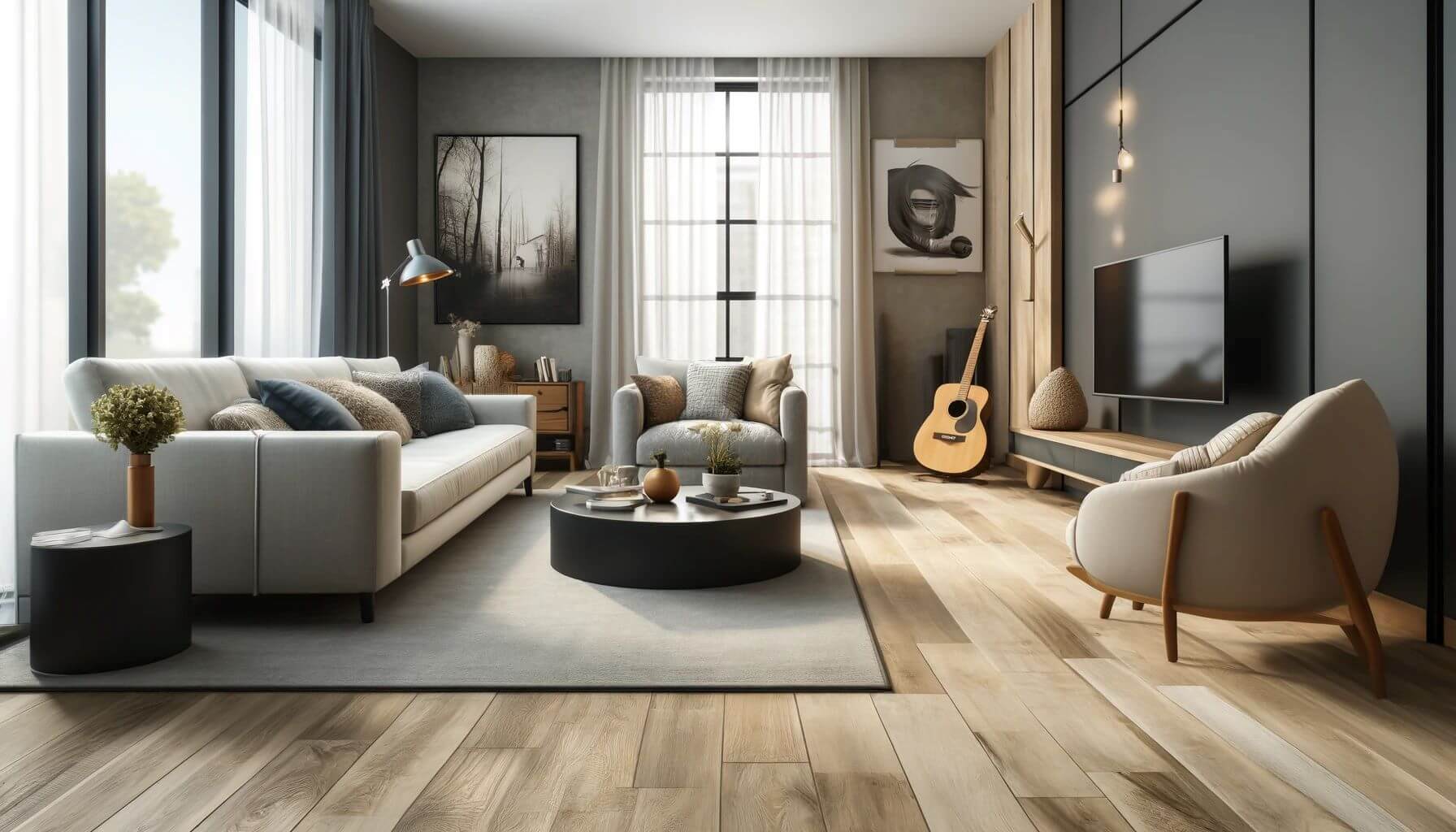
Two terms you’ll often come across when choosing the right flooring for your home are water-resistant and waterproof flooring. But what exactly do these terms mean, and how do they differ? In this article, we’ll dive into the world of water-resistant vs waterproof flooring to help you make an informed decision for your next flooring project.
What is Water-Resistant Flooring?
Water-resistant flooring is designed to withstand some exposure to moisture, but it’s not completely impervious to water. This type of flooring can handle spills and splashes, as long as they’re cleaned up promptly. Some examples of water-resistant flooring include:
- Laminate flooring
- Vinyl plank flooring
- Engineered hardwood
These flooring options have a protective top layer that helps prevent water from penetrating the surface. However, if water is left standing for too long or seeps into the seams, it can still cause damage over time.
What is Waterproof Flooring?
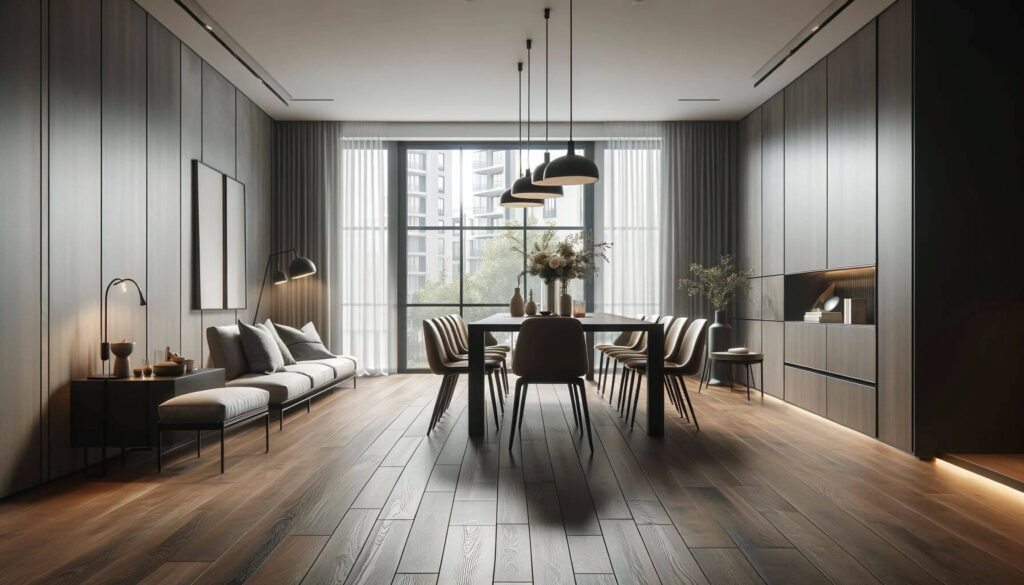
Waterproof flooring, on the other hand, is completely impervious to water. It’s designed to withstand exposure to moisture without any damage or deterioration. Some popular options for waterproof flooring include:
- Luxury vinyl plank (LVP)
- Porcelain tile
- Ceramic tile
These materials are ideal for areas prone to moisture, such as bathrooms, kitchens, and basements. They can handle spills, splashes, and even standing water without any issues.
Comparing Water-Resistant vs Waterproof Flooring
While both water-resistant and waterproof flooring offer some level of protection against moisture, there are some key differences to keep in mind:
- Durability: Waterproof flooring is generally more durable than water-resistant flooring. It can withstand more wear and tear, as well as exposure to moisture over time.
- Installation: Water-resistant flooring is often easier to install than waterproof flooring. Some options, like laminate and vinyl plank, can be installed as a floating floor over existing surfaces. Waterproof options like tile require more extensive installation processes.
- Cost: Water-resistant flooring tends to be more affordable than waterproof flooring. However, the added durability and moisture resistance of waterproof options may make them a better long-term investment.
Choosing the Right Flooring for your Needs
When deciding between water-resistant and waterproof flooring, consider the specific needs of your space. For areas like bathrooms and kitchens, waterproof flooring is often the best choice. It can handle the high levels of moisture and humidity in these spaces without any issues. For other areas of your home, like living rooms and bedrooms, water-resistant flooring may be sufficient.
Modern Living Room with Water-Resistant Flooring
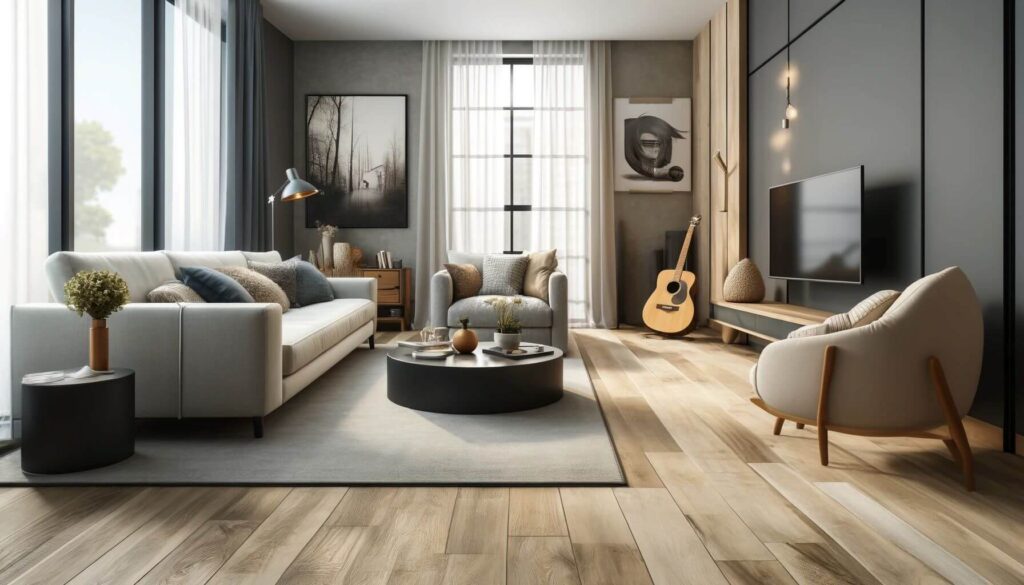
Water-resistant flooring in a living room offers both functionality and style. This type of flooring is designed to withstand spills and minor water exposure, making it ideal for busy households with kids or pets. In a modern living room setting, water-resistant flooring can feature a wood-like texture that enhances the aesthetic appeal while providing practical benefits. The natural light from large windows, cozy furniture, and stylish decor elements create a warm and inviting atmosphere, showcasing how water-resistant flooring can seamlessly blend with contemporary interior designs.
Sleek Kitchen with Waterproof Vinyl Flooring
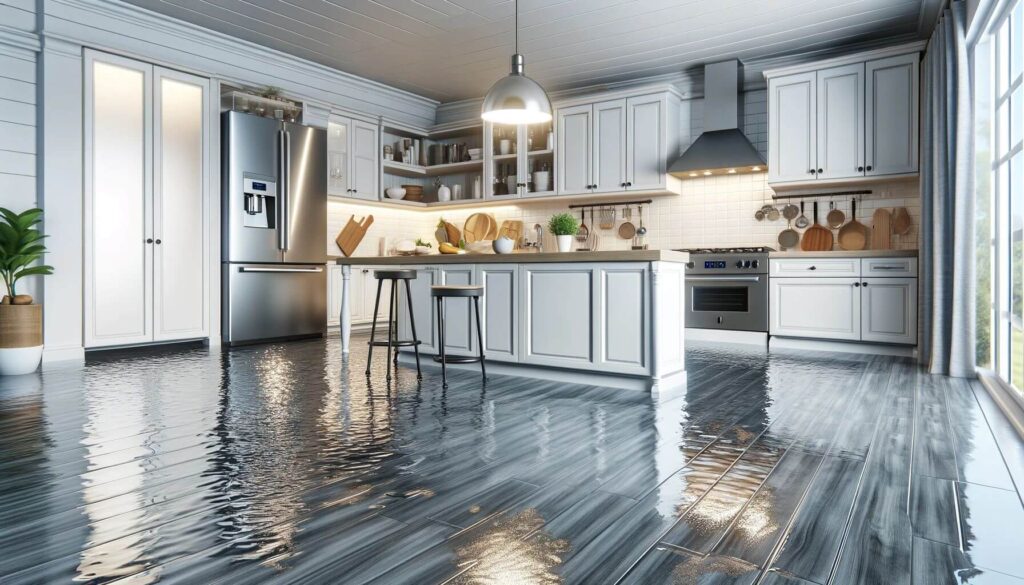
A sleek kitchen with waterproof vinyl flooring exemplifies modern elegance and practicality. Waterproof vinyl is perfect for kitchens due to its durability and resistance to water damage. This type of flooring can handle the inevitable spills and splashes that occur during cooking and cleaning without compromising its appearance. The combination of stainless steel appliances, white cabinets, and a large island highlights the kitchen’s contemporary design, while the wet floor demonstration underscores the robustness of waterproof vinyl. Homeowners can enjoy a stylish kitchen without worrying about water-related issues.
Cozy Bathroom with Waterproof Tile Flooring
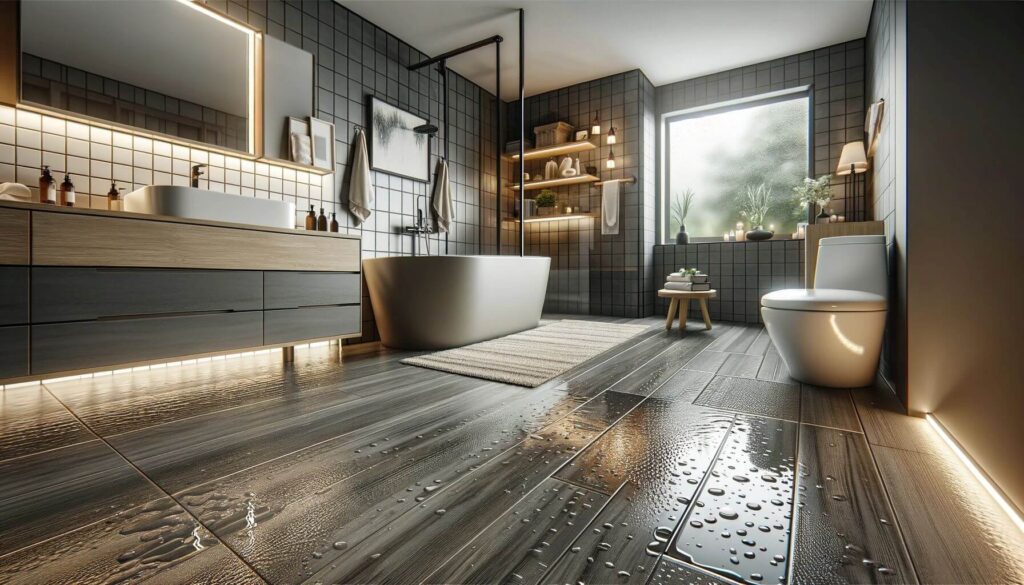
Waterproof tile flooring in a cozy bathroom setting provides a perfect blend of comfort and durability. Bathrooms are high-moisture areas, making waterproof flooring essential to prevent damage and maintain a clean, hygienic environment. The modern design, featuring a large bathtub, sleek sink, and stylish decor, is complemented by tile flooring that shows water droplets, indicating its ability to repel water effectively. This setup ensures that the bathroom remains pristine and functional, even with frequent water exposure.
Recreational Basement with Water-Resistant Laminate Flooring

A recreational basement with water-resistant laminate flooring is an excellent choice for creating a versatile and durable space. Basements are often susceptible to moisture, so having water-resistant flooring helps protect against potential damage. This type of laminate flooring is designed to withstand minor water spills, making it ideal for a recreational area that might include activities like games, watching movies, or lounging. The comfortable sofa, pool table, and vibrant lighting create an inviting atmosphere, demonstrating how water-resistant laminate flooring can enhance the functionality and aesthetic appeal of a basement.
Outdoor Patio with Waterproof Stone Flooring
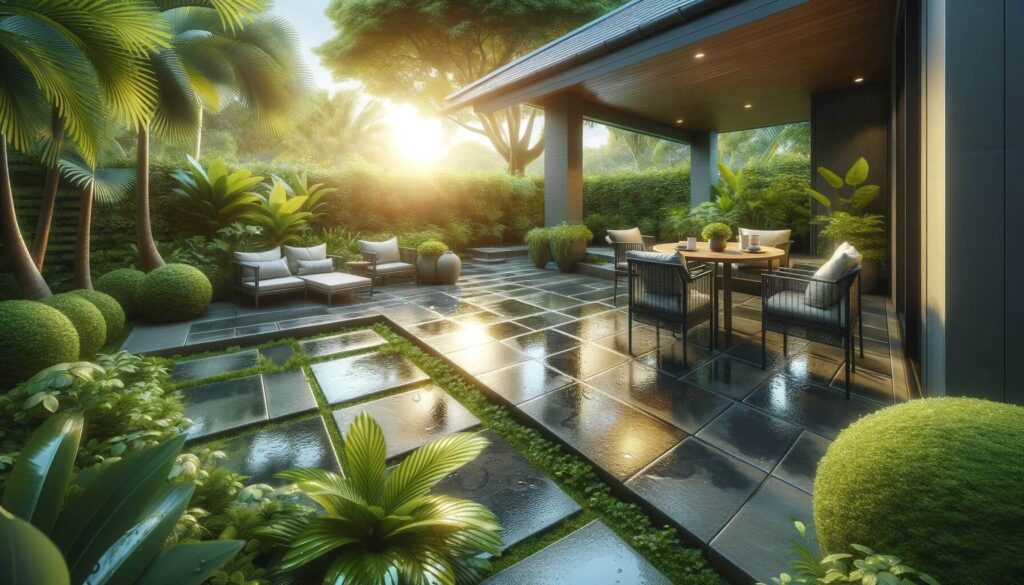
An outdoor patio with waterproof stone flooring is perfect for creating a durable and stylish outdoor living space. Stone flooring is naturally resistant to water, making it ideal for patios exposed to the elements. This type of flooring can handle rain and wet conditions without damage, ensuring the patio remains attractive and functional year-round. The seating area with a table and chairs, surrounded by lush greenery, showcases how waterproof stone flooring can enhance the outdoor experience, providing a beautiful and resilient surface for entertaining and relaxation.
Caring for your water-resistant or waterproof flooring
Regardless of whether you choose water-resistant or waterproof flooring, proper care and maintenance are essential to keep it looking its best. Here are some tips:
- Clean up spills and splashes promptly
- Use a damp mop or cloth to clean the surface regularly
- Avoid using harsh chemicals or abrasive cleaners
- Use protective pads under furniture to prevent scratches and dents
Explore your Options Water-Resistant vs Waterproof Flooring
Now that you understand the difference between water-resistant and waterproof flooring, it’s time to explore your options. Check out these resources for more information and inspiration:
- What flooring is 100% waterproof?
- Flooring for waterproof and scratch resistant
- Waterproof flooring laminate vs vinyl
- Vinyl plank flooring
- True waterproof laminate flooring
- Waterproof flooring thickness
- Pergo waterproof laminate
- Water resistant flooring material
No matter which option you choose, investing in water-resistant or waterproof flooring can help protect your home from moisture damage and keep your space looking beautiful for years to come.
When it comes to flooring, it’s not just about aesthetics. Durability and moisture resistance are key factors to consider, especially in areas like kitchens and bathrooms. That’s where the debate between water-resistant and waterproof flooring comes into play.
While both options offer some level of protection against moisture, they have some distinct differences. Water-resistant flooring can handle some exposure to water, but it’s not completely impervious. It’s a great choice for areas like living rooms and bedrooms, where spills and splashes are less common.
On the other hand, waterproof flooring is completely impervious to water. It’s designed to withstand high levels of moisture and humidity without any damage or deterioration. This makes it the ideal choice for spaces like bathrooms, kitchens, and basements.
When deciding between water-resistant and waterproof flooring, it’s important to consider your specific needs and budget. Water-resistant options like laminate and vinyl plank are often more affordable and easier to install, while waterproof options like luxury vinyl plank and tile offer added durability and moisture resistance.
No matter which option you choose, proper care and maintenance are essential to keep your flooring looking its best. Regular cleaning, prompt spill cleanup, and protective pads under furniture can all help extend the life of your flooring.
If you’re considering a flooring upgrade, be sure to explore all your options. From vinyl plank to laminate to tile, there are plenty of water-resistant and waterproof flooring materials to choose from. Check out the resources listed above for more information and inspiration.
In the end, the choice between water-resistant and waterproof flooring comes down to your specific needs and preferences. Whether you’re looking for affordability, durability, or complete moisture resistance, there’s an option out there for you.
So don’t let moisture damage put a damper on your home décor. Invest in water-resistant or waterproof flooring and enjoy a beautiful, long-lasting space for years to come. With the right flooring choice and proper care, you can create a space that’s both stylish and functional, no matter what life throws your way.



